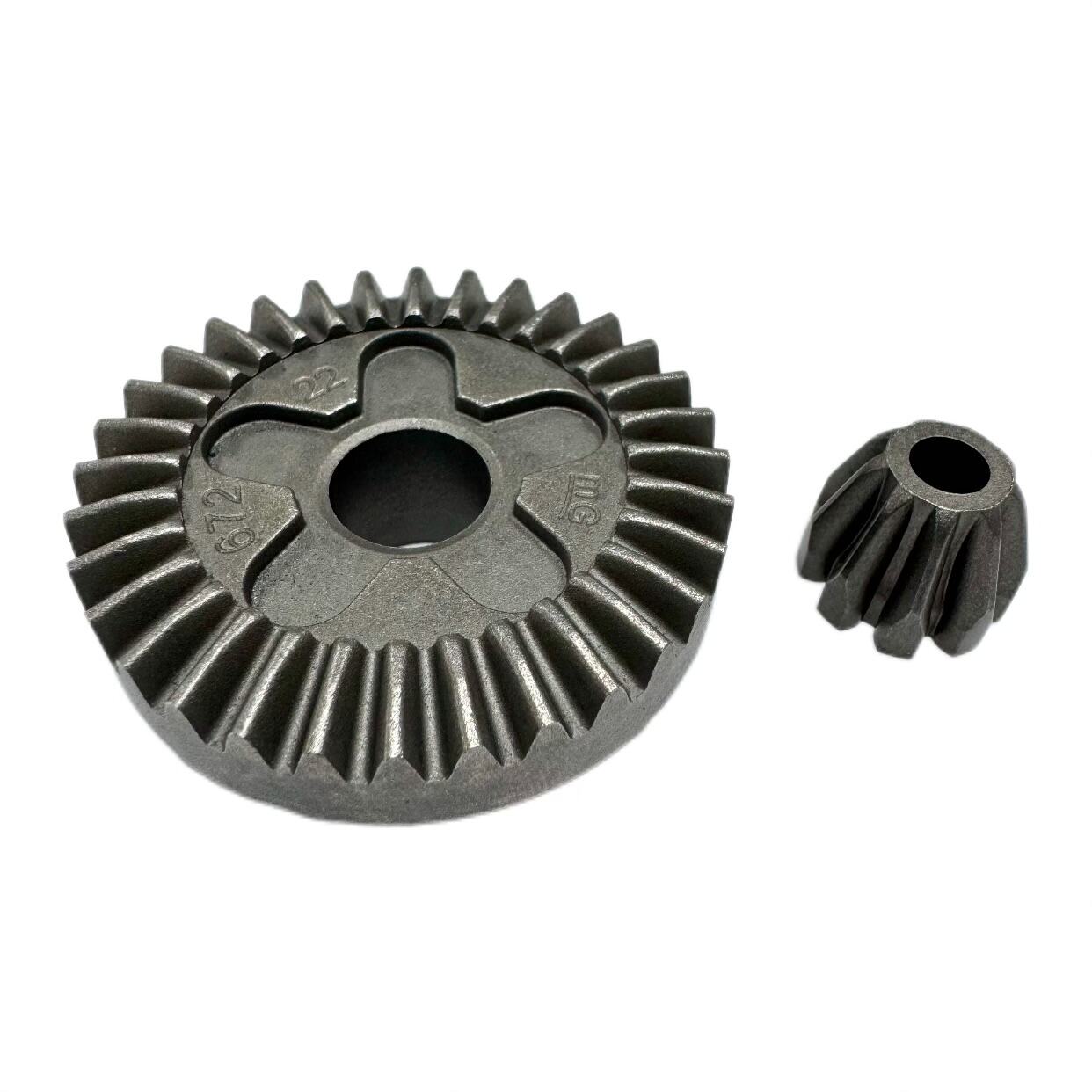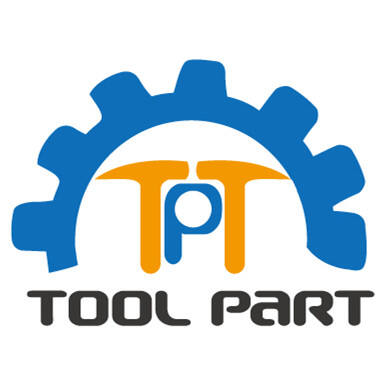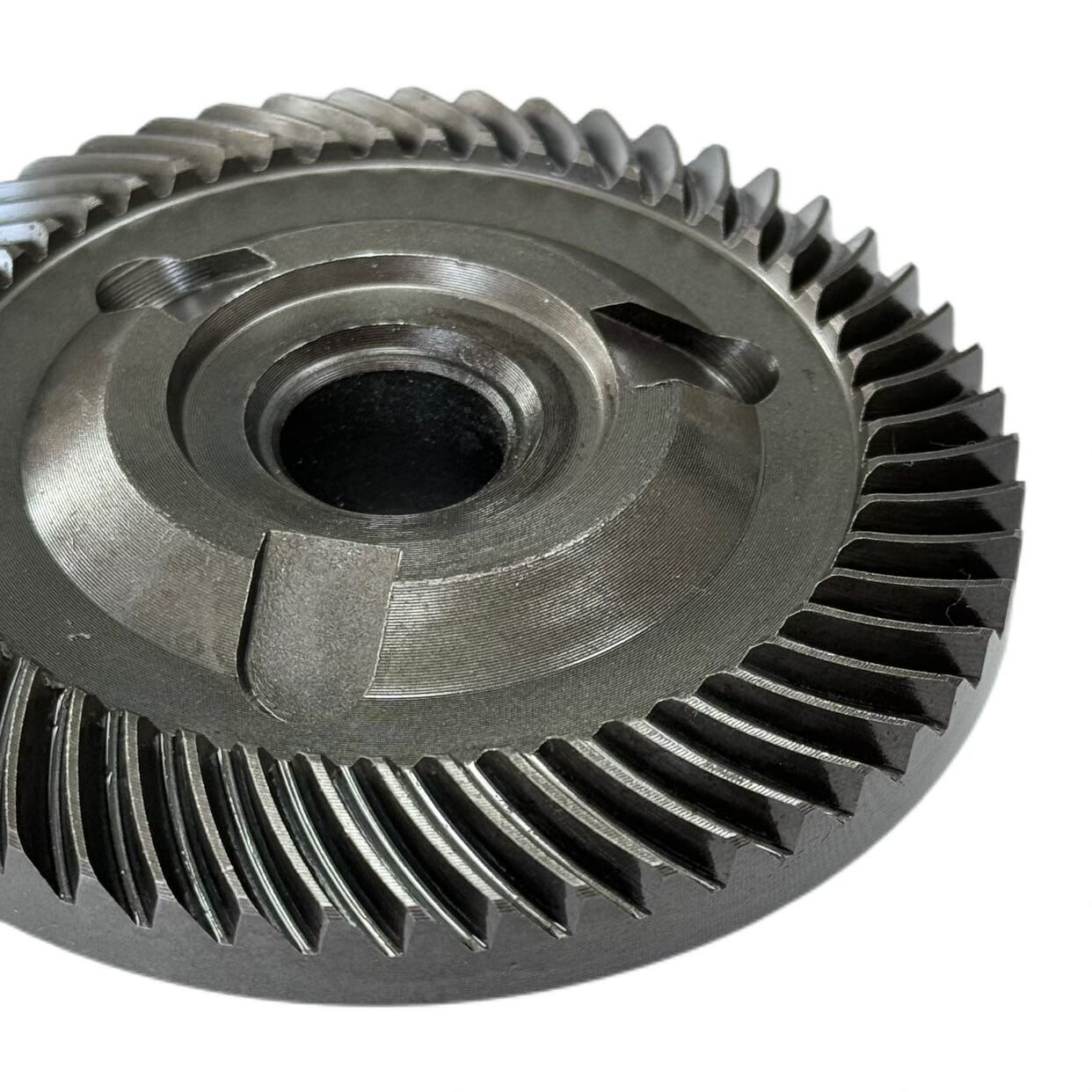الدور الأساسي لعجلات القيادة في كفاءة الأنظمة الميكانيكية
ضرب العزم من خلال نسب العتاد
تلعب تروس العجلات دوراً أساسياً في مضاعفة عزم الدوران داخل الأنظمة الميكانيكية، وذلك بشكل رئيسي من خلال تعديل نسب التروس. عندما تُستخدم تروس أكبر، فإنها تُعزز بشكل كبير كمية القوة الناتجة، وهو ما يفسر سبب أهمية هذه التروس للمواقف التي تتطلب قوة كبيرة. فهم كيفية عمل ذلك يمكّن المهندسين من تخصيص إعداداتهم الميكانيكية وفقاً لمتطلبات التشغيل. خذ على سبيل المثال صيغة نسبة التروس، فهي تخبرنا بشكل أساسي بمقدار عزم الدوران الذي سيُنتج من النظام، مما يوفر معلومات قيمة عند تصميم التروس، وهو أمر مهم للغاية مثل تصميم السيارات السباقية أو المعدات الثقيلة. أنواع مختلفة من التروس مثل التروس المستقيمة، والترس الحلزوني، والترس المخروطي تنتج جميعها مستويات متفاوتة من عزم الدوران، لذا فإن اختيار النوع المناسب يصبح أمراً بالغ الأهمية إذا كان الشخص يرغب في تحقيق أقصى أداء مع الحفاظ على الكفاءة عبر مختلف التطبيقات.
آليات نقل الطاقة في تكوينات عتاد العجلات
تلعب التروس الدوارة دوراً أساسياً في نقل الطاقة بسلاسة عبر الأنظمة الميكانيكية، وتعديل كل من السرعة والعزم بين المكونات المختلفة. عندما يفحص المهندسون كيفية ترتيب هذه التروس، يمكنهم تحديد الأماكن التي تُفقد فيها الطاقة على طول الطريق وإجراء التعديلات اللازمة لتعزيز الكفاءة العامة. بالنسبة للشركات التي تعمل على تطوير تصميمات أفضل للتروس، تصبح هذه التحليلات ضرورية لتحقيق استخراج طاقة أكبر من آلياتها. إن كفاءة انتقال الطاقة عبر نظام التروس لا تؤثر فقط على الأداء اليومي، بل تحدد أيضاً المدة التي سيظل فيها النظام صالحاً قبل الحاجة إلى قطع استبدال. يعرف قطاع السيارات هذا الأمر جيداً، وكذلك مصنّعو المعدات الثقيلة. من خلال فهم الأساسيات الخاصة بكيفية انتقال الطاقة عبر تروس العجلات، يمكن للمصممين إنشاء أنظمة توفر أداءً قوياً مع الحفاظ في الوقت نفسه على الطاقة، مما يمنحهم ميزة تنافسية على الشركات التي لم تتقن بعد هذه المبادئ الأساسية في الهندسة الميكانيكية.
المزايا الميكانيكية لتحسين ترس العجلات
تقليل فقدان الطاقة من خلال زيادة نسبة الاتصال
عندما نزيد نسبة التلامس في أنظمة التروس، فإن ذلك يقلل بشكل حقيقي من خسائر الطاقة المزعجة الناتجة عن الانزلاق والاشتباك غير الجيد بين الأسنان. تعمل التروس معًا بشكل أكثر سلاسة، وبالتالي يقل احتمال انزلاقها بجانب بعضها بدلًا من الدوران بشكل صحيح. هذا الأمر مهم جدًا في الأشياء مثل السيارات السباقية أو الآلات الصناعية حيث يكون كل جزء من القوة مهمًا. تشير بعض الدراسات إلى أن تعديل هذه النسب يمكنه تحسين الكفاءة بنسبة تتراوح بين 8 إلى 10 بالمئة. الآن، تستخدم الشركات نماذج حاسوبية لرؤية ما يحدث بالضبط عندما يتم تعديل المعايير المختلفة. توفر هذه المحاكاة أرقامًا دقيقة حول كيفية تأثير التغييرات على النظام ككل. وعندما تركز الشركات على تقليل خسائر الطاقة هذه من خلال تصميم التروس المناسب، فإنها في الواقع تحسن الأداء العام لآلياتها.
تقليل الاحتكاك من خلال توزيع الحمل
تقليل الحمل على أسنان التروس يقلل من الاحتكاك والتآكل، مما يجعل المكونات تدوم لفترة أطول. التروس التي تتوزع أحمالها على عدة أسنان لا تتعرض للإجهاد بشكل كبير. هذا يعني أنها لا تتآكل بسرعة، ويمكنها الاستمرار في العمل لسنوات بدلاً من أشهر. يستخدم المهندسون في كثير من الأحيان نماذج خاصة للتنبؤ بالتآكل لتحديد أفضل طريقة لتقليل الاحتكاك. تعمل هذه الأدوات بشكل جيد عندما نحافظ على المحاذاة الصحيحة ونحتفظ بالأحمال ضمن الحدود الآمنة. من خلال اتباع هذه النماذج، يمكن للمهندسين الميكانيكيين تطبيق استراتيجيات توزيع الأحمال التي تقلل من استهلاك الطاقة، لأن التروس لا تواجه مقاومة غير ضرورية. من الناحية العملية، يؤدي تقليل الاحتكاك إلى جعل التروس تدوم لفترة أطول، وفي الوقت نفسه تبقى الأنظمة الميكانيكية تعمل بسلاسة وكفاءة. هذا يوفر المال على فواتير الطاقة ويجعل الأنظمة بأكملها أكثر موثوقية على المدى الطويل.
علم المواد في أداء عجلات الدوران
معالجات سطح الأسنان المُصلدة لمقاومة البلى
عندما يتعلق الأمر بأداء تروس العجلات، فإن طرق تصلب السطح مثل الكربنة تُحدث فرقًا كبيرًا في صلابة أسنان التروس مع الحفاظ على مادة القلب قوية بما يكفي لتحمل الإجهاد الحقيقي. تعمل عمليات المعالجة الحرارية هذه على زيادة عمر الأنظمة الميكانيكية قبل الحاجة إلى قطع غيار، لأنها تقلل من التآكل والتلف الذي يؤدي إلى الأعطال. تُظهر الأبحاث أن التروس المعالجة سطحيًا تدوم عادةً لفترة أطول بكثير من تلك التي لم تُعالج على الإطلاق. تشير بعض الدراسات إلى أن المكونات المعالجة قد تعمل لمدة أطول بمرتين في الظروف العادية. يدرك معظم المهندسين أن اختيار المعالجة السطحية المناسبة أمر بالغ الأهمية اعتمادًا على مكان استخدام التروس. تحتاج التروس المعرضة لدرجات حرارة شديدة أو بيئات تآكلية إلى معالجات مختلفة عن تلك التي تعمل في إعدادات المصنع الخاضعة للرقابة، لذا فإن مطابقة المعالجة للتطبيق هو المفتاح للحصول على أقصى عمر خدمة للآلات باهظة الثمن.
أقراص سبيكة خفيفة لتقليل الكتلة الدورانية
يساعد استخدام سبائك خفيفة الوزن عند تصميم محابي العجلات في تقليل الكتلة الدوارة، مما يؤدي إلى تسارع أسرع وكفاءة أكبر في التشغيل. أظهرت الدراسات أن استخدام مواد أخف فعليًا يقلل من القصور الذاتي، ويعني أن الآلات لا تحتاج إلى قدر كبير من القدرة للعمل، مما ينتج عنه أنظمة أكثر استجابة ميكانيكية. إن نوع المادة المختارة لتلك المحابي يؤثر حقًا على كمية الوزن الذي يجب إدارته عبر النظام بأكمله. هذا الاختيار مهم جدًا لتحقيق أداء مثالي عبر مختلف أنواع التكوينات الميكانيكية. نحن نشهد زيادة في الأهمية التي يوليها المصنعون لهذا الجانب، حيث يسعون لجعل آليات التروس الخاصة بهم تعمل بشكل أفضل تحت مختلف الظروف التي تتطلب استجابات سريعة.
طلاء مقاوم للحفاظ على الكفاءة على المدى الطويل
تلعب الطلاءات دوراً أساسياً في حماية أسطح التروس من التآكل والصدأ، مما يساعد العجلات على أن تدوم لفترة أطول وأن تعمل بشكل أفضل وفقاً لغرضها المقصود. تشير الأبحاث إلى أن الطلاءات ذات الجودة الجيدة يمكن أن تطيل عمر التروس بنسبة تصل إلى مرة ونصف مقارنة بتلك التي لا تخضع لأي معالجة على الإطلاق. تبقى الحماية قوية بما يكفي لضمان أداء التروس بشكل جيد حتى بعد سنوات من الاستخدام. كما يلعب تطبيق هذه الطلاءات بشكل متساوٍ دوراً كبيراً أيضاً. وعند تنفيذه بشكل صحيح، لا تقوي تقنيات الطلاء السليمة التروس فحسب، بل تساعد أيضاً في تحسين وظائفها عبر كامل مساحة سطحها. بالنسبة للمصنعين في القطاعات مثل صناعة السيارات أو المعدات الثقيلة، فإن الاستثمار في هذه الطبقات الواقية منطقي، لأن التشغيل الموثوق به على مر السنين يعني حدوث أعطال وأعطال أقل تتطلب الاستبدال لاحقاً.

تحسين أداء عجلات العجلات من خلال التصنيع الدقيق
التحكم في الارتداد أقل من حدود 0.05 مم
من المهم للغاية الحفاظ على نسبة اللعب الخلفي ضمن حدود مقبولة عندما تحتاج التروس إلى الارتباط بشكل صحيح، حيث أن وجود لعب كبير جداً يؤدي إلى إحداث ضوضاء مزعجة واهتزازات غير مرغوب فيها أثناء التشغيل. تتيح الطرق الحديثة في التصنيع للشركات تحقيق التحملات الضيقة المطلوبة للتحكم الجيد في اللعب الخلفي، وهو ما يُحدث فرقاً كبيراً في بناء أنظمة ميكانيكية موثوقة. يلجأ المهندسون بشكل متكرر إلى المحاكاة عبر الحاسوب لدراسة تأثير الكميات المختلفة من اللعب الخلفي على الأداء العام، مما يساعد في تحديد أهداف واقعية لما يمكن تحقيقه في الظروف الفعلية. يستفيد قطاع السيارات بشكل خاص من هذا الاهتمام بالتفاصيل، وكذلك قطاع الطيران والفضاء، حيث تتحول التحسينات الصغيرة حتى إلى مكاسب كبيرة مع مرور الوقت. عندما يركز المصنعون بشكل جاد على تقليل اللعب الخلفي، فإنهم ينتهي بهم الأمر إلى إنتاج تروس عجلات ذات جودة أفضل تدوم لفترة أطول وتعمل بسلاسة أكبر في كل شيء من المعدات الثقيلة إلى المنتجات الاستهلاكية.
التحسين المجهرجي لتداخل سلس
عندما نقوم بتعديل الهندسة الدقيقة للأسنان في التروس، ما يحدث هو أن نقاط التلامس بينها تصبح أكثر نعومة بشكل ملحوظ. هذا يعني وجود مقاومة أقل عند دورانها معًا، مما يجعل كل شيء يعمل بكفاءة أكبر. أظهرت دراسات تبحث في الأنظمة الميكانيكية أن ضبط هذه الهندسة الدقيقة بدقة يمكن أن يقلل من الاحتكاك بشكل ملحوظ أثناء عمل التروس، مما يسمح بتداخلها بدون أي اهتزازات. يقضى المهندسون وقتًا طويلاً في إعداد نماذج أولية واختبار تصميمات مختلفة، بحيث يقومون بتعديل أشكال الأسنان وفقًا لأرقام الأداء الفعلية المستمدة من التطبيقات الواقعية. والنتيجة؟ تروس تعمل بشكل أفضل معًا. وبالإضافة إلى تحسين التروس الفردية فقط، فإن الاهتمام بهذه التفاصيل يساعد في رفع أداء النظام ككل، وهو أمر بالغ الأهمية في الآلات التي تعتمد على الدقة.
تحسين التشطيب السطحي من خلال الطحن المتقدم
إن الطحن الدقيق يُحدث فرقاً كبيراً من حيث نعومة أسنان التروس بالفعل، ويقلل من الأماكن الخشنة ويعزز من كفاءة عملها معاً. تُظهر الأبحاث أن الوصول بجودة تلك الأسطح إلى حوالي 0.1 ميكرون أو أفضل يقلل بشكل كبير من البلى مع مرور الوقت. عندما تدمج الشركات إنهاء السطح مباشرةً في عمليات تصنيعها منذ البداية، تميل التروس إلى العمل بهدوء لفترة أطول وتحقيق عمر افتراضي أطول بشكل ملحوظ. ما النتيجة؟ الأنظمة الميكانيكية تقدم أداءً أفضل لسنوات بدل أشهر. بالنسبة للمصانع التي تسعى للبقاء متقدمة في السوق اليوم، فإن الاستثمار في هذه التقنيات المتقدمة في الطحن يحقق عوائد من حيث تمديد عمر المنتجات وتقليل الشكاوى من العملاء حول الضجيج في المعدات على المدى الطويل.
استراتيجيات الحفاظ على كفاءة التشغيل
أنظمة التشحيم لإدارة الحرارة
تلعب أنظمة التزييت الجيدة دوراً مهماً حقاً في التحكم بالحرارة الناتجة عن الاحتكاك في التروس، مما يساعد على الحفاظ على سلامة هذه المكونات على المدى الطويل. ويعتمد اختيار نوع التزييت المناسب بشكل كبير على الظروف التي سيواجهها المعدّات، وهو ما يُحدث فرقاً كبيراً في قدرة المعدات على البقاء باردة أثناء التشغيل. تساعد بيانات التصوير الحراري فرق الصيانة في تحديد الأماكن التي قد تحتاج إلى تزييت إضافي استناداً إلى أنماط درجات الحرارة الفعلية التي تُرصد أثناء الظروف التشغيلية العادية. اعتماد هذا النوع من الاستراتيجيات الوقائية يعني أن التروس ستستمر في الدوران دون مشاكل، مع تجنّب نقاط تراكم الحرارة الخطرة التي قد تؤدي إلى أعطال مستقبلية. التزييت المناسب لا يوفّر المال فحسب على صعيد الإصلاحات، بل يعني أيضاً أن الماكينات تدوم لفترة أطول قبل الحاجة إلى قطع غيار.
تخفيف الاهتزاز من خلال التناسق الدقيق
إن تحقيق التوافيق بشكل دقيق يُحدث فرقاً كبيراً عندما يتعلق الأمر بتقليل الاهتزازات، والحفاظ على تشغيل التروس بسلاسة، وزيادة عمرها الافتراضي. عندما يتبع الفنيون إرشادات التوافيق المناسبة وفقاً لمواصفات الصناعة، تقل معدلات الأعطال في الآلات ويزداد عمرها الافتراضي بشكل عام. تعتمد العديد من الورش الآن على مناهج الصيانة التنبؤية التي تبدأ بتحليل أنماط الاهتزازات. تُنتج هذه الأساليب معلومات مفيدة تُحدد المشاكل قبل حدوثها فعلياً. ما النتيجة؟ تبقى العمليات فعّالة دون توقفات غير متوقعة، وتقل فواتير الإصلاح لأن المشكلات الصغيرة تُصلح قبل أن تتفاقم وتُصبح صداعاً كبيراً للجميع المعنيين.
الابتكارات المستقبلية في تقنية عتاد العجلات
تكامل المستشعرات الذكية لمراقبة الأداء
إن وضع أجهزة استشعار ذكية داخل أنظمة التروس يُحدث تغييرًا جذريًا في كيفية مراقبة هذه التجهيزات الميكانيكية وإصلاحها. تسمح لنا هذه الأجهزة بمراقبة الأداء في الوقت الفعلي، مما يحسّن بشكل كبير من قدرتنا على التنبؤ بمواعيد الحاجة إلى الصيانة مقارنة بما كان عليه الوضع من قبل. وبفضل جمع البيانات المستمر، يستطيع مشغلو المعدات معرفة متى قد يحدث عطل قبل حدوثه فعليًا. لقد شهدت بعض المصانع انخفاضًا في فواتير الإصلاحات بنسبة تصل إلى النصف بعد تركيب هذا النوع من المستشعرات. على سبيل المثال، أفادت مصانع إنتاج السيارات بأنها توفر آلاف الدولارات شهريًا فقط من خلال اكتشاف المشكلات الصغيرة مبكرًا. وبعيدًا عن توفير التكاليف، تسهم هذه الإضافات الذكية في الحفاظ على عمل التروس بكفاءة مع تقليل تلك الأعطال المفاجئة المزعجة التي تُربك الجداول الزمنية.
تطبيقات المواد المركبة لتحقيق وفورات في الطاقة
إن النظر إلى مواد مركبة متقدمة لتصنيع التروس يفتح إمكانياتٍ مثيرة للاهتمام من ناحية توفير الطاقة. تقلل هذه المواد الجديدة من وزن التروس بشكل ملحوظ مع الحفاظ على قوتها بما يكفي لتحمل الأحمال الثقيلة، مما يؤدي إلى تحسين أداء الأنظمة ككل. تشير الدراسات إلى أن الانتقال إلى المواد المركبة يقلل فعليًا من كمية الطاقة التي تحتاجها هذه الأنظمة أثناء التشغيل. نحن نشهد بالفعل هذا الاتجاه في المصانع، حيث تُحدث التروس المصنوعة من المواد المركبة ترسانًا معدنية تقليدية تدريجيًا تصبح غير مجدية. فهي لا تعمل بشكل أفضل فحسب، بل تحتاج أيضًا إلى صيانة أقل تكرارًا، مما يوفّر المال على المدى الطويل. ومع تشديد اللوائح المتعلقة بكمية الطاقة التي يمكن للمعدات الصناعية استهلاكها، يتجه العديد من المصنّعين إلى المواد المركبة باعتبارها خيارًا صديقًا للبيئة ووسيلة لتعزيز الأداء العام دون تكلفة مفرطة.
أنظمة تحسين نسبة العتاد بقيادة الذكاء الاصطناعي
استخدام الذكاء الاصطناعي لضبط نسب التروس بدقة باستخدام بيانات تشغيل فعلية يمثل تطوراً جوهرياً في كيفية تعاملنا مع تروس العجلات في الوقت الحالي. إن قدرة الذكاء الاصطناعي على التنبؤ بالنتائج تساعد المهندسين على اتخاذ قرارات أفضل أثناء تصميم واختيار التروس لمختلف التطبيقات. وقد أظهرت بعض الاختبارات التي أُجريت في ورش التصنيع مكاسب حقيقية في كفاءة تشغيل الآلات بعد تطبيق حلول الذكاء الاصطناعي. يمكن لهذه الأنظمة الذكية أن تُعدّل إعدادات التروس بشكل فوري، مما يعني أداءً أفضل للآلات ككل، وزيادة عمر القطع، وانخفاض الحاجة إلى الصيانة بسبب الأعطال. وعلى الرغم من أن هذه التقنية لا تزال في مراحلها الأولى، فإن دمج الذكاء الاصطناعي في أنظمة التروس يحمل مستقبلاً واعداً لجعل الإعدادات الميكانيكية أكثر ذكاءً وانخفاض التكاليف التشغيلية على المدى الطويل، وهو أمر تهتم به الشركات المصنعة كثيراً بينما تتجه نحو أساليب إنتاج أكثر استدامة دون التأثير على الأداء.
الأسئلة الشائعة
ما هو الدور الأساسي لأنظمة التروس في الأنظمة الميكانيكية؟
تلعب أنظمة التروس أدوارًا حيوية مثل ضرب العزم والنقل الكهربائي، مما يمكّن الأنظمة الميكانيكية من العمل بكفاءة تحت ظروف مختلفة.
كيف يمكننا تحسين أداء أنظمة التروس؟
يمكن تحسين أداء عجلات القيادة من خلال طرق مثل التحكم في الفجوة الخلفية، وتعديلات الميكروجيوميتري، وتقنيات الطحن المتقدمة لتحسين الدقة والكفاءة.
ما هي المواد المستخدمة في بناء عجلات القيادة لتحقيق كفاءة أعلى؟
تُستخدم مواد مثل السبائك الخفيفة والطلاءات القوية في بناء عجلات القيادة لتقليل الكتلة الدورانية وحماية ضد التآكل، مما يزيد من عمرها الافتراضي وكفاءتها.
كيف تحسن التكنولوجيات المتقدمة مثل الذكاء الاصطناعي أنظمة عجلات القيادة؟
تساعد تقنيات الذكاء الاصطناعي في تحسين نسب التروس وصيانة التنبؤ، مما يؤدي إلى زيادة كفاءة النظام وتقليل التآكل وعمليات اقتصادية.
لماذا تعتبر المستشعرات الذكية مهمة في أنظمة عجلات القيادة؟
تمكّن المستشعرات الذكية من مراقبة الوقت الحقيقي والصيانة التنبؤية، مما يساعد على تقليل وقت التوقف وتحسين الأداء العام للنظام.

